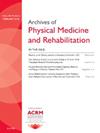软可穿戴机器人提供反重力臂支持,提高个人中风后上肢运动质量
IF 3.6
2区 医学
Q1 REHABILITATION
Archives of physical medicine and rehabilitation
Pub Date : 2025-05-01
DOI:10.1016/j.apmr.2025.03.011
引用次数: 0
摘要
中风后的运动障碍限制了手臂对抗重力的功能移动能力,导致上肢运动质量下降。因此,提供反重力臂支持被广泛采用为运动康复的有效策略,以实现功能性上肢运动。最近,我们开发了一种柔软的可穿戴肩式机器人,它通过安装在定制衬衫上的手臂下方的气动致动器来解除手臂的重力。本研究旨在评估软性可穿戴机器人在改善中风后个体上肢运动质量方面的有效性。我们招募了4名中风后患者(年龄 = 60.5±18.3岁,UE-FMA评分 = 45.5±11),要求他们在机器人打开和关闭的情况下,将手臂对抗重力抬起90°弯曲和外抬,各3次。我们使用光学运动捕捉系统来记录和评估上肢运动,通过计算1)肩部升降运动范围(ROM), 2)末端执行器运动质量(三维(3D)手质心(COM)轨迹的手径比),以及3)躯干补偿(3D躯干COM的位移)。我们发现,软体可穿戴机器人使四名参与者的肩部抬高/下沉ROM平均增加了6.1±1.7°。此外,该机器人通过平均降低手径比(50.9±7.7%)和躯干位移(15.3±6.7%),提高了末端执行器的运动质量,减少了躯干补偿。运动质量的改善突出了我们的设备在上肢运动康复中的潜在效用。本文章由计算机程序翻译,如有差异,请以英文原文为准。
Soft Wearable Robot that Provides Anti-Gravity Arm Support Improves Upper Limb Movement Quality in Individuals Post-Stroke
Post-stroke motor impairments limit the ability to functionally move the arm against gravity which leads to a reduction in upper limb movement quality. Hence, providing anti-gravity arm support is widely adopted as an effective strategy in motor rehabilitation to enable functional upper limb movement. Recently, we developed a soft wearable shoulder robot that lifts the arm against gravity using a pneumatic actuator attached underneath the arm on a custom-made shirt. This study aims to evaluate the effectiveness of the soft wearable robot in improving upper limb movement quality for individuals post-stroke. We recruited four individuals post-stroke (age = 60.5±18.3 years, UE-FMA scores = 45.5±11) and asked them to lift their arm against gravity to 90° flexion and abduction, three times each with the robot turned on and off. We used an optical motion capture system to record and evaluate upper limb movement by calculating 1) shoulder elevation/depression range of motion (ROM), 2) end-effector movement quality (hand-path-ratio of the three-dimensional (3D) hand center of mass (COM) trajectory), and 3) trunk compensation (displacement of 3D trunk COM). We found that the soft wearable robot increased shoulder elevation/depression ROM, on average, by 6.1±1.7°, for the four participants. Additionally, the robot improved end-effector movement quality and reduced trunk compensation by decreasing hand-path-ratio and trunk displacement, on average, by 50.9±7.7% and 15.3±6.7%, respectively. The demonstrated improvement in movement quality highlights the potential utility of our device for upper limb motor rehabilitation.
求助全文
通过发布文献求助,成功后即可免费获取论文全文。
去求助
来源期刊
CiteScore
6.20
自引率
4.70%
发文量
495
审稿时长
38 days
期刊介绍:
The Archives of Physical Medicine and Rehabilitation publishes original, peer-reviewed research and clinical reports on important trends and developments in physical medicine and rehabilitation and related fields. This international journal brings researchers and clinicians authoritative information on the therapeutic utilization of physical, behavioral and pharmaceutical agents in providing comprehensive care for individuals with chronic illness and disabilities.
Archives began publication in 1920, publishes monthly, and is the official journal of the American Congress of Rehabilitation Medicine. Its papers are cited more often than any other rehabilitation journal.

 求助内容:
求助内容: 应助结果提醒方式:
应助结果提醒方式:


